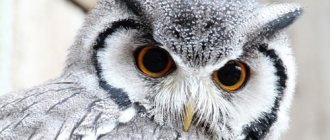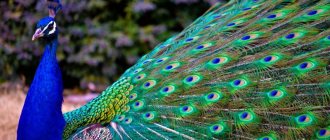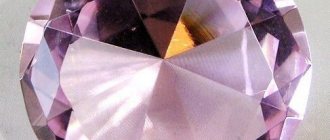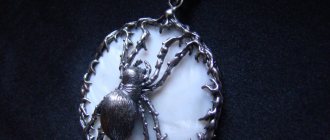Due to its colorful plumage, the peacock has been a symbol of the sun in southern Asian countries. It represented diversity, joy of life, beauty, longevity and love. The bird's bushy tail was associated with nobility, power, glory, greatness and pride. In India and Byzantium, the peacock was revered as a royal bird. Indians considered the peacock a symbol of fertility and abundance, the animal of the god Brahma, as well as an attribute of Lakshmi, the god of passionate love Kama, the wise goddess Saraswati - the patroness of the arts, music and poetry. The motif of Krishna dancing with the peacocks symbolized life as a holiday, joy and admiration of all that is beautiful.
The incarnation of the god Vishnu - Krishna dances and rejoices while peacocks watch him
There were legends about the peacock that he, as a messenger of the sun, fights his enemies - snakes, and by killing them, converts snake venom into solar energy.
The Iranian cosmogonic myth of the races says that God first created the peacock as the embodiment of the world soul. Afterwards, he let the peacock see his reflection in the magic mirror, and the peacock was delighted with his beauty.
Peacock - coat of arms of the Chinese imperial Ming dynasty
Droplets of sweat shed by the peacock fell to the ground, and from them came all life on earth.
In the Islamic tradition, the peacock was considered the personification of the cosmos and was often depicted as a symbolic representation of the sun and moon. The Yazidi sect, “devil worshipers,” interpreted the peacock as a messenger of God, the king. They call him Malaki-Taus (or Melek-Tauz), a fallen angel who is also associated with the active transformative power of the cosmos.
Constellation Pavo. Illustration from Astronomical J. Amigoni. Juno receives the head of Argos. atlas “Uranography” by J. Hevelius
In classical Islam, the peacock is used as a symbol of the dual nature of man, royal power, and a metaphor for pure, unclouded contemplation of truth. The meanings of the peacock associated with admiration, true vision, and contemplation are most likely associated with the abundance of white spots similar to “eyes” on its feathers.
In modern Europe, the symbolism of the peacock received a negative connotation, including due to the fact that such a beautiful bird had a disgusting voice. The peacock came to be considered a symbol of arrogance, pomposity, pride and vanity.
Coat of arms of Serpukhov
Symbol of countries and cities
National bird of India
The blue peacock was officially elected as the national bird of India in 1963. The choice was between him and the bustard. The association of the royal bird with Indian culture has an ancient history. Birds were deified by the ancient Hindus, as evidenced by the myths that have reached us.
The peacock has been involved in the life of a Hindu since childhood - he is the hero of fairy tales and legends, songs and poems.
Birds live near cities and settlements, therefore they are in interaction and close connection with the local population.
The greatness and beauty of this feathered representative of the fauna is combined with an unpretentious disposition, which is why it is rightfully called the national bird of India.
Other countries and cities
The green peacock has been the national symbol of Myanmar since 1940. The culture of the country was greatly influenced by the royal nobility of India, so the similarity of the symbols of the states is natural.
In the ancient Egyptian Heliopsis there was a temple of the sun, so a representative of the pheasant family, as a sign of the luminary, became a symbol of this city.
The symbol of the peacock or its feather is widely represented in heraldry. In Russia this is the city of Serpukhov.
The bird also adorns the coat of arms of cities:
- Newark-on-Trent (Britain);
- Albach (Germany);
- Saint-Paul-Cap-de-Joux (France);
- Pego (Spain).
LiveInternetLiveInternet
Myanmar
Before the English conquest, the flags of the Burmese kings featured a green peacock. This image continued to be used later - in colonial and post-colonial times. For example, the flag of the Burmese State in 1943-1945. was the current flag with the difference that instead of a white star, there was an image of a peacock in the center of the banner.
Since 1940, the Burmese subspecies of the Javan peacock (P. m. spicifer) has been the national symbol of Myanmar (the second national bird in the world; the first is the bald eagle, the national symbol of the United States since 1782).
Found in the wild at altitudes up to 900 m in Java, Myanmar, Thailand, Laos, Cambodia, Vietnam and southern China. Significantly inferior in number to the common peacock. In the second half of the 20th century, the range and abundance of the species decreased significantly. The current status of the species, according to the classification of BirdLife International and the International Union for Conservation of Nature (IUCN), is defined as “vulnerable”.
Most people believe that the magnificent feathers make up the peacock's tail. But in fact, this is not a tail, but a kind of train. These feathers belong to the lower part of the body and back. The train is raised and held up by the stiff feathers of the shorter, true tail, which lies behind and supports these feathers.
The peacock is considered a symbol of wisdom due to the many “eyes” on its tail. The peacock in many cultures is associated with astral symbolism; it personifies the starry sky, the Sun, and, accordingly, is an emblem of pride, immortality, beauty and fearlessness. And in Buddhist mythology, the peacock is a symbol of compassion and vigilance.
The peacock became an emblem of immortality: the Greeks, having learned through the Persians about the properties of this bird, depicted peacocks sitting on the chariots of the gods, not only as an adornment worthy of the gods, but also as an emblem of the immortality of the gods. It is not surprising that, combining such outstanding qualities as beauty, fearlessness in the fight against snakes (the personification of evil) and incorruptibility, the peacock became a sacred majestic bird in the eyes of people.
There are many legends about peacocks. Peacocks kill snakes, bringing considerable benefit to human settlements. Since snakes were considered enemies of the sun in Iranian symbolism, the peacock was believed to kill snakes in order to use their venom to create iridescent bronze-green and blue-gold “eyes” on its tail feathers. The beauty of the peacock's plumage is due to its ability to transform the venom of the snake it has struck. With a snake in its beak, the peacock symbolizes the victory of light over darkness. Added to this legend was the idea that peacock meat was indestructible.
Peacock and snake
Sufi parable
One day, a young man named Adi, nicknamed the calculator because he studied mathematics, decided to leave Bukhara and go in search of great knowledge. His teacher advised him to go south and said: - Find out the meaning of the peacock and the snake. Young Adi reflected on these words on the road. His path lay to Iraq through Khorasan. When he reached the end of the road, he actually saw a snake and a peacock. Adi spoke to them. “We compare our merits,” they said. “Continue, please,” said Adi, “this is exactly what interests me extremely.” “I think that I am much more important than a snake,” the peacock began. — I personify inspiration, aspiration to heaven, heavenly beauty, in other words, knowledge of lofty things. My purpose is to remind a person of his own qualities hidden within him. “I,” hissed the snake, “personify the same thing.” Like a person, I am tied to the earth. In this way I remind the person of himself. I am as flexible as he is, because I crawl on the ground, wriggling. People often forget about this. According to legend, I am the guardian of underground treasures. - But you are disgusting! - exclaimed the peacock. - You are cunning, secretive, poisonous. “You list my human traits,” answered the snake, “while I want to point out my purpose, which I just described.” But look at yourself. You are vain, disgustingly fat and have a nasty voice, your legs are excessively large, and your feathers are too long. Here Adi intervened in the conversation: “Watching your argument, I realized that none of you is completely right.” Yet you can clearly see, if you put aside your personal prejudices, that together you are an instructive example for humanity. And Adi explained to them what their purpose was, and they listened to him silently. - A person is tied to the earth, like a snake. He has the ability to fly up like a bird. But, having something of a greedy snake in him, he remains selfish even in this high aspiration and becomes like a peacock inflated with pride. In the peacock we see great human capabilities that were never able to develop correctly. The sparkling scales of a snake speak of possible beauty, and in the peacock this possibility is manifested in the flashy variegation of the tail. As soon as Adi said this, he heard a voice inside himself that said to him: “And that’s not all.” The two creatures you see in front of you are endowed with life. This basically represents their properties. They argue with each other because each of them is attached to his own way of life, believing that by his existence he realizes something true. However, the snake guards the treasure, but cannot use it. The peacock, reflecting beauty, reminds of treasures, but this does not help him change at all. Although they themselves are unable to derive any benefit from what they have, their example serves as an edification to those who can see and hear.
Dawn
The serpent looked, and the fiery links stretched out, slowly turning pale, but bright stones burned on the chest of the powerful serpent.
How wonderfully bright he is, how wonderfully scary! But the Peacock is both strict and incomprehensible, Its golden tail is decorated with a thousand multi-colored spots.
They waited silently at the threshold, Only the angel moved his wings, And feathers fell from paradise in Light, through clouds.
How many of them piled up, turning white, like snow over a fragile cornfield! And the emeralds of the Snake and the Peacock fan went out.
What do we need in the pale morning deception? Both the Peacock and the Snake are strangers to people. Now they have melted into the fog, and we will not see them again.
We tremble like little children, We are frightened by time raids, We will go to pray at dawn In the gentle marble grottoes.
N. Gumilev
We, beggars, saw the Virgin Mary pass by the round palace; like an echo of an unearthly melody, a radiance wafted from the thin face.
Midday clouds, silently capricious, silver crushed in the deep blue. Three smooth peacocks swam out from under a palm tree and dropped their feathers, and each feather -
sometimes shining in the shade, sometimes in the sleepy sun, a light green, with a velvet eye, magically bordered with dark azure, fell on the marble like a curved flower.
We, beggars, saw how, with a wonderful smile, the incomparable Virgin raised her feathers and wove a shimmering, blue, emerald wreath for Christ, a child in thought.
Vladimir Nabokov August 2, 1920
Flight of the Indian peacock:
Universal symbol
Divine Bird
- In India, the peacock is a sacred bird. Religions in other countries also use this symbol.
- Representatives of Christianity respect birds, considering them a symbol of divine reverence. The “eyes” on the feathers symbolize the “all-seeing” Church. The ability to renew (change plumage) has caused Christians to associate it with immortality. And the legend that speaks of the incorruptibility of the meat of this bird made the peacock a symbol of resurrection. He is often depicted on icons dedicated to Christmas. The Great Martyr Barbara holds in her hand the feather of a sacred bird as a sign of her immortality.
- Buddhism recognizes the bird as a symbol of compassion and vigilance. His feather is an attribute of Avalokiteshvara.
- In Islam, the peacock's "eye" symbolizes clairvoyance and intuition.
- In the Yazidi religion, the archangel Tausi Malak appears in the form of a peacock.
- Peacock feather is an attribute of Lord Krishna. For Hare Krishnas, this bird symbolizes immortality. The "Eye" represents the all-seeing eye of Krishna.
Symbol of the Chosen
In ancient China, the emperor encouraged his subjects by giving them a feather from a sacred animal. Having received the favor of the emperor, the Chinese were ranked among the highest strata of society. Therefore, the talisman is still used as a symbol of dignity and greatness. The beautiful bird is the totem animal of the Ming Dynasty.
In Iran, the Shah's court was called the "Peacock Throne".
In Rome, bird feathers were the emblem of the empress and her daughters. The image of a peacock was used on coins as a sign of the divinity of the imperial daughters.
Astral symbolism
In Ancient Greece, the peacock's tail, decorated with multi-colored patterns and precious stones, was the embodiment of the endless starry sky. One of the myths tells of the revival of the hundred-eyed Argos by the goddess Hera, who transferred the eyes of the sleepy hero to the tail of a beautiful pheasant.
According to the legends of the ancient world, these birds symbolize the entire cosmos or the moon and sun separately.
New in blogs
Peacock - the colorful diversity of the world. The peacock is often made to personify the endless variety, the cheerful spirit with which God created this earth, having fun as he wanted. An ornamental bird originating from India, where, thanks to its luxurious fan-shaped tail, it was considered a symbol of the Sun. Together with the Chinese pheasant (which belong to the same family), they were exotic birds in ancient Europe, and may have influenced the artistic description of the legendary Phoenix bird.
A solar symbol associated with the cult of the tree and the Sun. Symbolizes immortality, longevity, love. A natural symbol of the stars in the sky and, as a result, ascension to Heaven and immortality. Radiant glory, immortality, greatness, incorruptibility, pride. The sparkling splendor of the tail of the male peacock is the reason for his comparison with the immortal gods, and therefore with immortality. Peacocks are widely known as an emblem of greatness, royalty, spiritual superiority, the ideal creature.
The peacock (Pavo cristatus) is one of the largest representatives of the gallinaceae order. An ordinary peacock of strong build with a rather long neck, a small head bearing a peculiar crest, short wings, high legs and a medium-length tail. The male is especially characterized by unusually developed upper tail coverts, forming what is commonly called the “tail” of the peacock. This amazingly luxurious, ocellated “tail” blooming in a huge fan and beautifully colored brilliant plumage, which combines blue, green and red tones, created the peacock’s reputation as the most beautiful bird among chickens.
Many years of discussions about the role of the peacock's tail ended in a compromise: the size of the male's tail does play a role in the mating ritual, but females are more likely to weed out completely unsuitable candidates based on this criterion, rather than choose the very best. “The very sight of peacock feathers makes me sick,” wrote Charles Darwin in 1860. The huge, flowery and seemingly completely useless tail of the peacock did not fit into the theory of natural selection.
The trait must help its carrier survive, otherwise the animal simply dies and the trait is not passed on to the offspring. But in the end, the great scientist came out of the situation by proposing the so-called sexual selection, when some traits help not to survive, but to find a partner for reproduction. and the peacock's tail shows female peacocks which of the gentlemen is more attractive.
In recent years, however, considerable debate has erupted over the peacock's tail. In the 1980s, Marion Petrie from the University of Newcastle (UK) set out to experimentally confirm the role of the peacock's tail in the mating ritual of birds. Her main parameter was the number of ocellated spots that the male demonstrates when revealing his economy.
According to observations, males with the greatest number of such “eyes” had the greatest success; if a peacock, even the most popular one, lost feathers, its chances of leaving offspring were sharply reduced. The Darwinian theory was also supported by subsequent data from French scientists from the National Museum of Natural History in Paris, who found that the number of “eyes” on the tail feathers is an indicator of the strength of the immune system.
In a word, females, choosing the most “big-eyed” peacock, at the same time choose the healthiest one. Scientists observed wild peacocks over several breeding seasons, also paying attention to what would happen to a male that lost some of its tail feathers. It turned out that peacocks do not like males with a small number of eyes on their tails, but to the same extent they ignore “champions”! The greatest success among females is enjoyed by gentlemen with a certain average value of the “luxury” of the tail, in which the number of eye patterns ranges from 165 to 170 patterns.
Zoologists believe that the tail apparently works at the first stage of selection of a sexual partner: females are more likely to reject insufficiently suitable males based on this characteristic, rather than choosing the best ones. At the same time, researchers note that the size of the tail may be more important for scientists than for peacock ladies. Birds are able to simultaneously “calculate” many parameters, including the style and color scheme of the tail, and in general look primarily not at the tail, but at other signs.
But you can only ask the peacocks themselves about this. Peacocks are known not only for their luxurious tail, but also for their extremely dissonant cry. For a long time it was believed that this cry was the only means of communication among these birds, until researchers from the University of Manitoba (Canada) discovered another sound signal from peacocks, which, however, is inaccessible to the human ear. At the annual conference of the Society for Research in Animal Behavior, zoologists reported that male peacocks can emit infrasound, and they do this with the help of the same tail.
If you watch a male who has unfolded his tail, you will notice how from time to time a small trembling runs through the tail feathers, running from the base of the tail to the edge. The sounds that accompany such shaking are similar to the rustling of leaves - but this is only what the human ear can detect. The researchers found that this produces another sound, with a frequency below 20 Hz, which the male directs using his open tail: a circle of feathers with curved edges serves as something like a transmitter dish.
The fact that a bird or animal can emit infrasound signals is not news: the capercaillie, for example, has the same ability. But peacocks are unique in this sense, because they clearly use infrasound for communication. When zoologists played the recorded infrasound signal to other peacocks, the females began to look around restlessly, and the males responded with the famous meowing cry. According to scientists, this is the only example of birds using infrasound for communication. The meaning of the message that peacocks convey to each other using their sounding tail is not entirely clear, but it is probably more convenient to warn each other about danger in dense bushes.
The trait must help its carrier survive, otherwise the animal simply dies and the trait is not passed on to the offspring. But in the end, the great scientist came out of the situation by proposing the so-called sexual selection, when some traits help not to survive, but to find a partner for reproduction.
So the peacock’s tail shows female peacocks which of the gentlemen is more attractive. In recent years, however, considerable debate has erupted over the peacock's tail. In the 1980s, Marion Petrie from the University of Newcastle (UK) set out to experimentally confirm the role of the peacock's tail in the mating ritual of birds. Her main parameter was the number of ocellated spots that the male demonstrates when revealing his economy. According to observations, males with the greatest number of such “eyes” had the greatest success; if a peacock, even the most popular one, lost feathers, its chances of leaving offspring were sharply reduced.
The Darwinian theory was also supported by subsequent data from French scientists from the National Museum of Natural History in Paris, who found that the number of “eyes” on the tail feathers is an indicator of the strength of the immune system. In a word, females, choosing the most “big-eyed” peacock, at the same time choose the healthiest one.
Peacock in a dream
A peacock appearing in a dream can symbolize hopes and fantasies or an arrogant person.
- Feeding a bird in a dream means that an approach will be found to an unapproachable person.
- According to the dream book, seeing a peacock spreading its tail in a dream is a sign of deception. If the tail is not loose, this means minor troubles.
- If a peacock loses a feather in a dream, it means exposing an influential person.
- You dream of a screaming peacock to remind you of some small but important matters.
- A dream from Wednesday to Thursday promises a fun pastime for the rest of the week. And if you dreamed about the bird from Sunday to Monday, then renovations will soon begin in the house.
Negative symbol value
Only the rich classes could breed peacocks. Due to its association with luxury and vanity, the bird has become a symbol of arrogance and arrogance. Hence the expression “spread its tail like a peacock.” In mockery of feigned arrogance, the famous Faina Ranevskaya once said: “Under the most beautiful peacock tail hides the most ordinary chicken ass. So less pathos, gentlemen".
In England it is not customary to keep peacock feathers in the house. "Eye" reminds the English of the evil eye and is associated with bad luck. The British believe in omens: the owner may be in big trouble; and the unmarried women in the house will not find a husband.
In South Asia, the bird is considered a harbinger of trouble. She warns of approaching predators and thunderstorms.
Alchemical peacock
Even the Gnostics considered the peacock a mystical creature. They were sure that his beautiful tail was a combination of 365 colors, which corresponded to the number of existing heavens through which divine energy emanated. The peacock's tail, shimmering with all the colors of the rainbow, was depicted by alchemists as an allegory of the beginning of the transformation of lower substances into higher ones. Sometimes the peacock denoted experiments, as a result of which it was not possible to achieve the formation of a precious metal and only slag was produced.
Illustration from the alchemical treatise “The Radiance of the Sun,” 16th century.
Peacock feathers in the home
In contrast to the folk signs of the British, the teachings of Feng Shui equate peacocks with a deity. And the white peacock is a symbol of spirituality and spiritual harmony. Bird feathers are attracted to the home:
- wealth;
- luxury;
- success in business;
- Love;
- beauty;
- fantasy.
It is possible to put things in order at work or get a promotion with the help of this talisman.
Bird feathers placed in the house of a lonely person will attract love to the house.
It is possible to “appease” the talisman so that it works with the help of praise.











